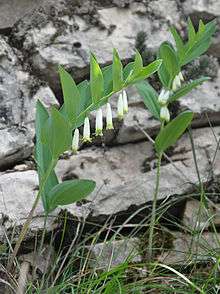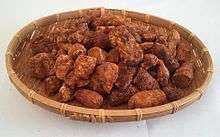Polygonatum odoratum
Polygonatum odoratum (angular Solomon's seal or scented Solomon's seal) syn. P. officinale, is a species of flowering plant in the family Asparagaceae, native to Europe, the Caucasus, Siberia, the Russian Far East, China, Mongolia, Korea and Japan.[1][2][3][4] In the United Kingdom it is one of three native species of the genus, the others being P. multiflorum and P. verticillatum.
| Polygonatum odoratum | |
|---|---|
 | |
| Polygonatum odoratum | |
| Scientific classification | |
| Kingdom: | Plantae |
| Clade: | Tracheophytes |
| Clade: | Angiosperms |
| Clade: | Monocots |
| Order: | Asparagales |
| Family: | Asparagaceae |
| Subfamily: | Nolinoideae |
| Genus: | Polygonatum |
| Species: | P. odoratum |
| Binomial name | |
| Polygonatum odoratum (Mill.) Druce | |
| Synonyms[1] | |
| |
Description
Polygonatum odoratum is a colonizing herbaceous perennial growing to 85 cm (33 in) tall by 30 cm (12 in) wide, with alternate, simple leaves on arching stems. The scented tubular flowers are white with green tips, borne in spring and hanging from the underside of the stems.[2]
Cultivation
Polygonatum odoratum, like its relative lily of the valley, is cultivated in moist, shaded situations, where it will spread by underground stolons.[5] Cultivars include 'Flore pleno'[6] and 'Variegatum'.[7]
Use

Polygonatum odoratum is used in traditional Chinese medicine and Traditional Korean medicine, where it is called yùzhú (玉竹) and dunggulle (둥굴레) respectively. In Korea, the root of the plant is used to make tea.
This plant species is described in the work Plantas Medicinales (medicinal plants) of Pius Font i Quer.[8] According to it, its rhizome contains asparagine, mucilage, a cardio-tonic glycoside, saponin, and quinine gluconate. It has been used for intestinal problems and pain, for rheumatism, gout, water retention, and as a diuretic. He says that the scientific medicine has used it to treat diabetes. Also describes a digestive liquor that uses the rhizome of this plant.
Varieties
Four varieties are recognized:[1]
- Polygonatum odoratum var. maximowiczii (F.Schmidt) Koidz. – Japan, Russian Far East
- Polygonatum odoratum var. odoratum – widespread from Portugal and Great Britain to Japan and Kamchatka
- Polygonatum odoratum var. pluriflorum (Miq.) Ohwi – Japan, Korea
- Polygonatum odoratum var. thunbergii (C.Morren & Decne.) H.Hara – Japan, Korea
References
- Kew World Checklist of Selected Plant Families
- RHS A-Z encyclopedia of garden plants. United Kingdom: Dorling Kindersley. 2008. p. 1136. ISBN 1405332964.
- Flora of China, Vol. 24 Page 226, 玉竹 yu zhu, Polygonatum odoratum (Miller) Druce, Ann. Scott. Nat. Hist. 60: 226. 1906.
- Altervista Flora Italiana, Sigillo di Salomone comune, Angular Solomon's Seal, Polygonatum odoratum (Miller) Druce includes map of distribution in Europe
- "RHS Plant Selector – Polygonatum odoratum". Retrieved 28 May 2013.
- "RHS Plant Selector – Polygonatum odoratum 'Flore Pleno'". Retrieved 28 May 2013.
- "RHS Plant Selector – Polygonatum odoratum 'Variegatum'". Retrieved 28 May 2013.
- Pius Font i Quer, Plantas medicinales, editorial Labor, 1962
External links
| Wikimedia Commons has media related to Polygonatum odoratum. |